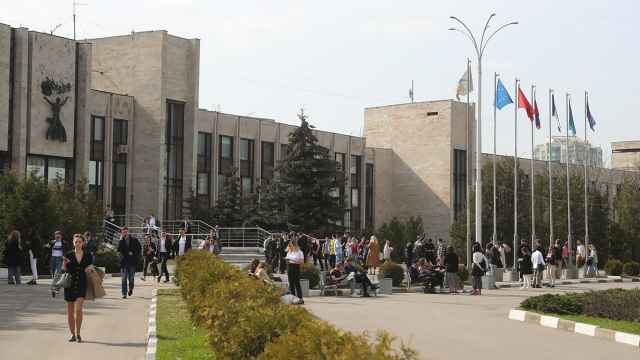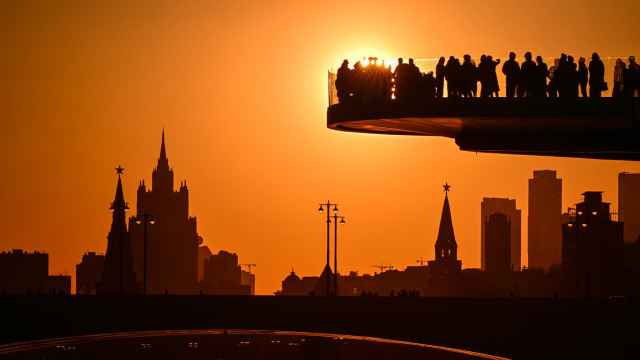Russian politicians and analysts are working hard this week to create a cloud of doubt around the Aug. 21 chemical attack outside Damascus.
On Friday, the White House report drew on extensive intelligence information to present this picture: Syrian forces carried out chemical weapons attacks on sleeping Damascus suburbs, killing 1,429 civilians, including 426 children.
On Saturday, President Vladimir Putin told reporters that because the Syrian government is on the offensive it would be "utter nonsense" for it to use chemical weapons.
One century ago, Russia's elites were better educated on the realities of poison gas as a military weapon.
In World War I, officers drew on Old Testament analogies to warn their soldiers of "Dyma Kaina" (The Smoke of Cain).
The mustard gas of Ypres on the Western Front is better known today, but the first massive use of gas as a war weapon took place against Russian soldiers in January 1915. German units fired 18,000 artillery shells filled with liquid xylyl bromide tear gas on Russian positions west of Warsaw during the Battle of the Bolimov.
By the time World War I ended, the biggest victim of poison gas attacks was Russia.
Russia lost 56,000 soldiers to gas in World War I — 63 percent of the war's gas fatalities. Russia recorded 419,340 soldiers injured by gas, 34 percent of the total recorded by all nations.
However, during World War I, the Western Front had better painters than the Eastern Front.
Ninety-five years to the day before the Damascus attack, on Aug. 21, 1918, the American painter John Singer Sargent was with British soldiers when German units barraged them with mustard gas. From sketches and notes, he painted "Gassed." This nearly life-size oil painting was voted picture of the year by the Royal Academy of Arts in 1919.
Of equal impact on public opinion were Britain's war poets Siegfried Sassoon and his friend, Wilfred Owen.
In 1917, while recovering from war wounds, Owen wrote "Dulce et Decorum Est." He called it "a gas poem."
Here is an excerpt:
"Gas! GAS! Quick, boys! — An ecstasy of fumbling, / Fitting the clumsy helmets just in time;/ But someone still was yelling out and stumbling/ And flound'ring like a man in fire or lime . . . / Dim, through the misty panes and thick green light,/ As under a green sea, I saw him drowning. / In all my dreams, before my helpless sight,/ He plunges at me, guttering, choking, drowning."
International revulsion over the use of gas in warfare prompted governments to meet in Geneva to draw up one of the world's first arms control agreements. Known as the Geneva Protocol, the agreement went into effect in February 1928. It carried this title: Protocol for the Prohibition of the Use in War of Asphyxiating, Poisonous or other Gases, and of Bacteriological Methods of Warfare.
Two months later, the protocol was signed by the Soviet Union — the successor state to Tsarist Russia, World War I's largest victim of poison gas.
Forty years later, in 1968, the Geneva Protocol was signed by Syria. Syria's defense minister at the time was Hafez Assad, father to Syria's current president, Bashar Assad.
As president during the 1980s, the elder Assad, apparently with Soviet assistance, built up a powerful chemical weapons arsenal.
In the last two years, his son Bashar has steadily escalated attacks on his political opponents — from beating demonstrators to shooting them, from shelling residential neighborhoods to dropping bombs from warplanes.
In recent weeks, Bashar Assad's forces apparently carried out limited chemical weapons attacks. The response from the West was muted. Russia's state-controlled TV and think tanks suggested that opposition forces were gassing themselves in order to win international support.
Now, Assad has taken the next step in his ruthless logic, checking the wind and then gassing sleeping residents on the eastern edge of his capital.
If Washington undertakes punitive strikes against Assad's military, the Russian chattering class might do well to step back and take a break from attacking the United States. Instead, as Russia stands one year away from the 100th anniversary of its August 1914 entry into World War I, Russians might find it interesting to contemplate the fact that their own soldiers were the first victims of modern gas warfare.
In that case, the "fog of war" was real — and deadly.
James Brooke, based in Moscow, is the Russia/CIS bureau chief for Voice of America.
A Message from The Moscow Times:
Dear readers,
We are facing unprecedented challenges. Russia's Prosecutor General's Office has designated The Moscow Times as an "undesirable" organization, criminalizing our work and putting our staff at risk of prosecution. This follows our earlier unjust labeling as a "foreign agent."
These actions are direct attempts to silence independent journalism in Russia. The authorities claim our work "discredits the decisions of the Russian leadership." We see things differently: we strive to provide accurate, unbiased reporting on Russia.
We, the journalists of The Moscow Times, refuse to be silenced. But to continue our work, we need your help.
Your support, no matter how small, makes a world of difference. If you can, please support us monthly starting from just $2. It's quick to set up, and every contribution makes a significant impact.
By supporting The Moscow Times, you're defending open, independent journalism in the face of repression. Thank you for standing with us.
Remind me later.





